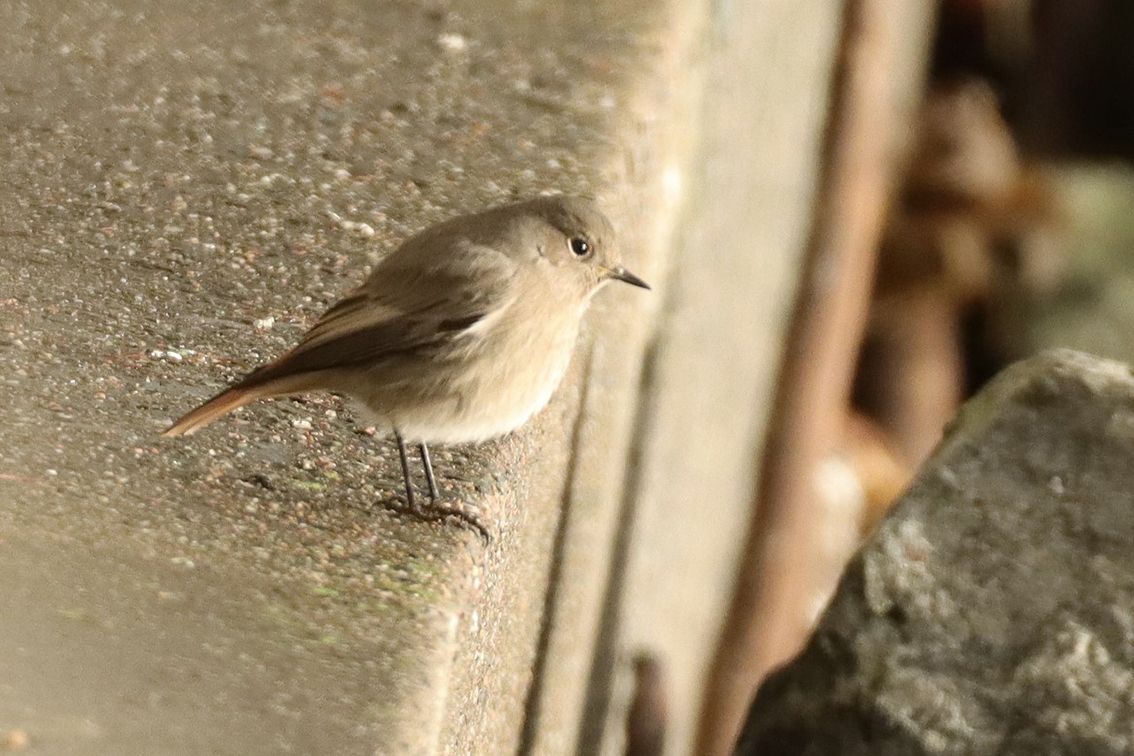THIS wee bird transfixed Dúlra this week. And no wonder. Because he’s never set eyes on it before – and, indeed, few Irish people have. And yet here it was on the rocks at Whitehead, as tame as a robin in your garden.
Dúlra visits the seaside outpost of Whitehead every winter because it’s a landing zone for countless birds fleeing bad weather in Scotland – and a big proportion of those have made the incredible journey through Scotland from Scandinavia. Dúlra’s watched birds arrive at Whitehead so famished that you pick them up – they collapse on the shore like marathon runners crossing the finishing line.
But that’s during stormy weather. This Tuesday was glorious and Whitehead was like a picture postcard as gentle Irish Sea waves lapped the shoreline where plovers and countless waders enjoyed the January sun.
There had been talk on Twitter that a rare visitor had been spotted here – not a seabird at all, but an exotic flycatcher: the black redstart. Unlike Irish flycatchers, this is no bird of lush fields or forests – traditionally it’s at home at cliff-faces. The black redstart first bred in Britain on the southern coast in 1923 and then in the 1940s colonised bombed areas of London, where it nested amid the rubble. As these areas were repaired it retreated to derelict industrial estates and remote places like power stations and sewage works, which means it’s rarely seen, even by birdwatchers. But it never really managed to successfully colonise Britain and today there are just an estimated 44 breeding pairs there.
And so to see one in our own county this week is nothing short of incredible, at least for Dúlra.
As soon as he arrived he spotted it sitting on the concrete wavebreaker along the seafront between two pied wagtails. It looked like a robin at first, minus the red breast. This was a female, which is greyish with the only splash of colour in its unusual brown tail. Dúlra focused the binoculars and let all the finer details burn into his brain – he knows he’ll never get another chance in this lifetime.
She was restless, constantly darting up the concrete barrier, twisting in mid-air to grab a fly and then back to her perch, sometimes on the rocks, at other times on the concrete itself. As she flew, her tail opened like a fan, that unique brown highlighted by the sun. She must have been relieved that the sun was so strong, because in January Ireland isn’t noted for its flies.
With the British population so small, it’s likely this bird came from Europe, travelling across Britain before spotting that beautiful green land across the sea and deciding to take one last flight into the unknown. And she ended up just outside Larne.
Dúlra couldn’t get enough of her. A few passers-by out for a seaside dander said hello – and Dúlra just had to lower the bins and share the good news. “Look, it’s a black redstart!” he told them, pointing at the dot in the distance. “Right,” each one said, before walking on, bemused.
The earrdheargán dubh has never bred in Ireland, despite us having no lack of suitable bombed-out habitats! Only once a pair decided to spend summer in Wicklow way back in 1971, although they didn’t breed. The black redstart of Whitehead will no doubt be off back across the Irish Sea in spring, hopefully finding a mate along the way.
In the meantime, for once this shy wee flycatcher that is finding itself the centre of attention – and deservedly so.
• “Can you tell me how to keep cats out of my garden – there’s so many different birds here and we feed and water them, but they’re being tortured. We found a dead wood pigeon yesterday. I watch as much as I can, but I can’t be there all the time. It heartbreaking – we love the birds so much.”
Ann, Springfield Road.
Dúlra writes: It’s a modern curse. Of course cats make lovely pets, but they represent alien and invasive predators that Irish birdlife haven’t developed any natural protection to. As a bird-lover, Dúlra can only hope that people think twice before getting a cat. Just try to scare them off as Dúlra does – or get a dog to do the work for you!
If you’ve seen or photographed anything interesting, or have any nature questions, you can text Dúlra on 07801 414804.







